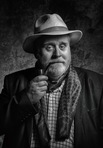Stevyn Colgan's Blog, page 2
August 12, 2019
Wet. Wet. Wet.
My new novel,
Cockerings
, is now 25% funded - we're quarter of the way there!
But we can't afford to take our feet off the pedal yet. There's still a long way to go.
And speaking of a long way, I just spent a long weekend in Scotland doing two performances of my talk Life, The Universe, And Elderberries for the Edinburgh Fringe and for Glasgow Skeptics.
It was also my birthday on the 11th. I spent it getting wet.
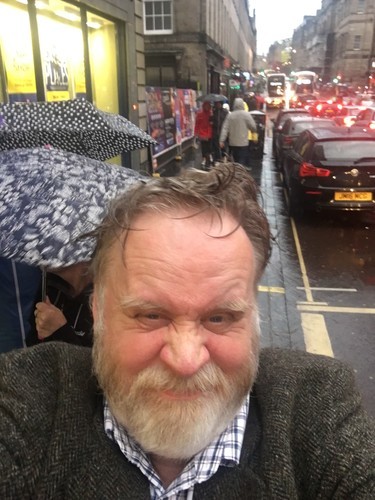
Yes indeed, it rained from the time I got up until the time I went to bed. It did not stop for even a second. The Royal Mile flowed like a river. The Grassmarket was awash. Supermarkets in Leith were flooded and shoppers were using canoes for trolleys. Okay, the bit about the canoes was an exaggeration. But by gum did it rain.
But, undaunted, I began the day with a pilgrimage to Greyfriars Kirkyard; not to see the wee dog with the shiny nose known as Greyfriars Bobby, but to find the memorial dedcated to Scotland's (and perhaps the world's) worst poet, William Topaz McGonagall.
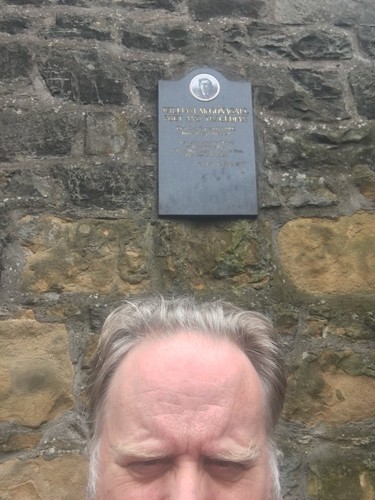
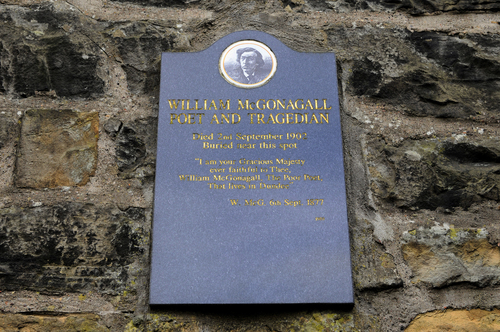
It's hard to get a decent shot of it (or even read it) as it's mounted high on a wall but what it says is:
WILLIAM McGONAGALL, POET AND TRAGEDIAN Died 2nd September 1902 Buried near this spot "I am your Gracious Majesty Ever faithful to thee, William McGonagall, the poor poet, That lives in Dundee."
Sadly, no one knows exactly where the great man's bones lie but, like his poetic rhyming schemes, they're somewhere close. Other literary worthy mentions include The Elephant House cafe where J K Rowling wrote the first Harry Potter book. It was packed with teenagers carrying wands. No, really.
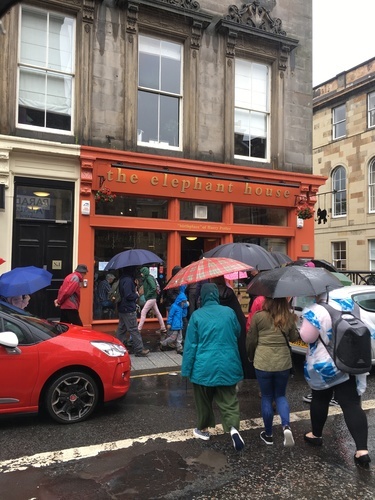
And there are plenty of other places in Auld Reekie that a HP licensed tour guide will be happy to point at and tell you that it inspired XXX in the books. And, let's face it, there is a castle on the hill and the tattoo, which looks a lot like a place where you'd play quidditch.

I thoroughly enjoyed myself and my talk went swimmingly (and, indeed, many of the people who came probably swam home). But now it's nose to the grindstone and back to funding Cockerings .
If you haven't already, please pledge a sum to pre-order a paperback or ebook copy. And if you have, bully your friends and relatives into doing the same.
The sooner it's funded the sooner you get it!
Click here and join my lovely gang of patrons.
But we can't afford to take our feet off the pedal yet. There's still a long way to go.
And speaking of a long way, I just spent a long weekend in Scotland doing two performances of my talk Life, The Universe, And Elderberries for the Edinburgh Fringe and for Glasgow Skeptics.
It was also my birthday on the 11th. I spent it getting wet.

Yes indeed, it rained from the time I got up until the time I went to bed. It did not stop for even a second. The Royal Mile flowed like a river. The Grassmarket was awash. Supermarkets in Leith were flooded and shoppers were using canoes for trolleys. Okay, the bit about the canoes was an exaggeration. But by gum did it rain.
But, undaunted, I began the day with a pilgrimage to Greyfriars Kirkyard; not to see the wee dog with the shiny nose known as Greyfriars Bobby, but to find the memorial dedcated to Scotland's (and perhaps the world's) worst poet, William Topaz McGonagall.


It's hard to get a decent shot of it (or even read it) as it's mounted high on a wall but what it says is:
WILLIAM McGONAGALL, POET AND TRAGEDIAN Died 2nd September 1902 Buried near this spot "I am your Gracious Majesty Ever faithful to thee, William McGonagall, the poor poet, That lives in Dundee."
Sadly, no one knows exactly where the great man's bones lie but, like his poetic rhyming schemes, they're somewhere close. Other literary worthy mentions include The Elephant House cafe where J K Rowling wrote the first Harry Potter book. It was packed with teenagers carrying wands. No, really.

And there are plenty of other places in Auld Reekie that a HP licensed tour guide will be happy to point at and tell you that it inspired XXX in the books. And, let's face it, there is a castle on the hill and the tattoo, which looks a lot like a place where you'd play quidditch.

I thoroughly enjoyed myself and my talk went swimmingly (and, indeed, many of the people who came probably swam home). But now it's nose to the grindstone and back to funding Cockerings .
If you haven't already, please pledge a sum to pre-order a paperback or ebook copy. And if you have, bully your friends and relatives into doing the same.
The sooner it's funded the sooner you get it!
Click here and join my lovely gang of patrons.
Published on August 12, 2019 04:38
August 3, 2019
When Clown (Names) Go Bad
A couple of blogposts ago (see here) I told the story of how
Cockerings
grew from a police promotion exam question into a complete novel. From the outset, one of the stars was a character called Bozo the clown. In the original exam question he was an alcoholic from Silesia (a former region of Europe now mostly in Poland) and he had a pet monkey called Caprino. The monkey has disappeared as the novel has evolved and much of the plot has changed. But throughout the last twenty-odd years of re-writes and edits, Bozo has remained the same.
Until now, that is. It is my sad duty to inform you that Bozo is no more.
It suddenly occurred to me that, with Bozo finally going public, I'd better check that there isn't a real Bozo that I might offend. After all, clowns may not be as popular as they once were, but I'd hate to damage someone's career.
So, first things first, it was off to East London to check out the Clown Egg Register.
Holy Trinity church in Dalston is home to the Clowns’ Gallery Museum, run by Clowns International. That's Joseph Grimaldi there in the stained glass window.
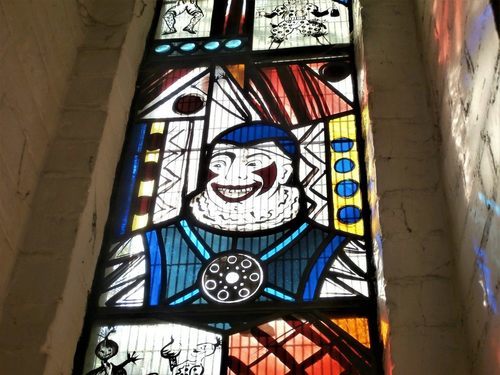
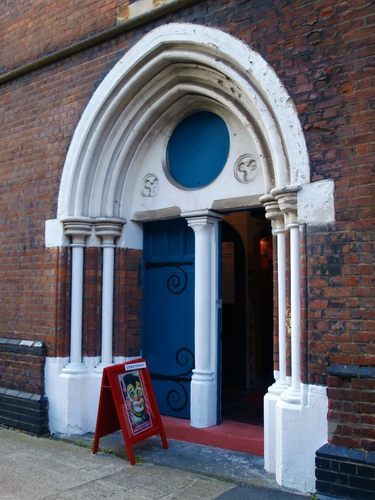
It's a tiny little place full of memorabilia and photographs crammed into three small rooms. But what I was interested in was the register - an archive of ceramic eggs painted to record clowns' personal makeup designs - like a kind of copyright record. The practice started in 1946 when a member of Clowns International (then called the International Circus Clowns Club) called Stan Bult painted the clown faces on emptied-out chicken eggs as a hobby. It evolved into a useful record of faces for posterity, as well as a way to memorialise the great clowns of yore. Bult painted around 200 eggs in total, and while most were lost or broken over the years, 26 of these fragile originals can be found at Dalston along with another 46 ceramic eggs on permanent display. The rest of the clown egg collection is held at Wookey Hole in Somerset.
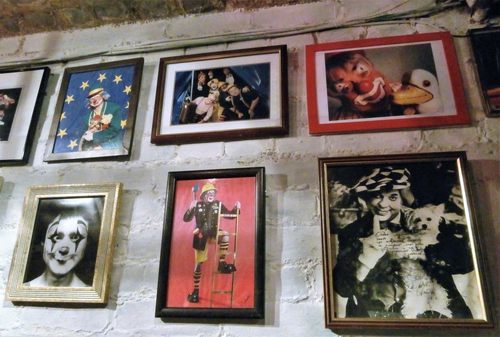

I first learned about the collection when a fictional version of it appeared in an episode of the classic British 'spy-fi' series The Avengers. There's a series 7 episode called (Stop me if you've heard this one) But there were these two fellers in which a young John Cleese runs the Clown Egg Registry and is visited by Tara King.
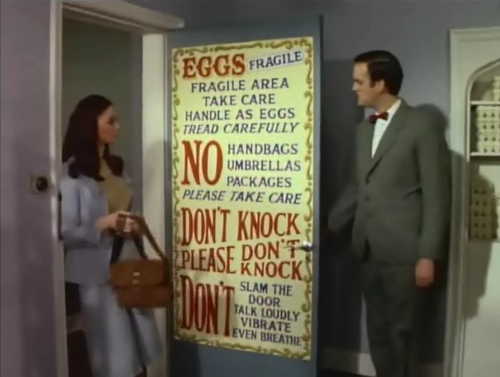
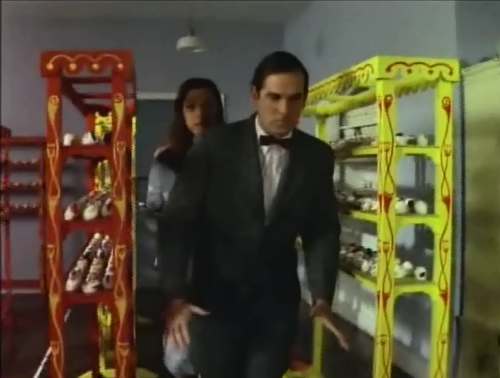
I long believed it to be something made up for the show but then, to my delight, I discovered back in the 1990s that it's quite real.
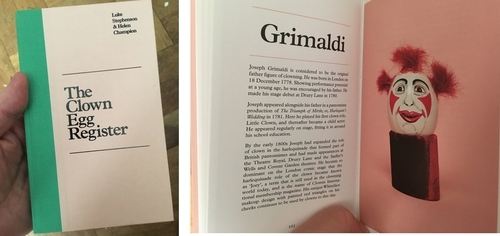

The registry at Dalston caught the attention of photographer Luke Stephenson in 2007 and he published a book of his fantastic photographs of the eggs, taken at Dalston and Wookey Hole.
It's a great little book and, to my delight, it contained no Bozos. And nor did the museum at Dalston. Further researches showed me that there was no registered clown working in the UK under the name. But, and it's a BIG but, when I looked further afield I realised that there was no way I could use the name.
Because, you see, in America Bozo the Clown is as well-known as Basil Brush or the Chuckle Brothers are over here. Sob!
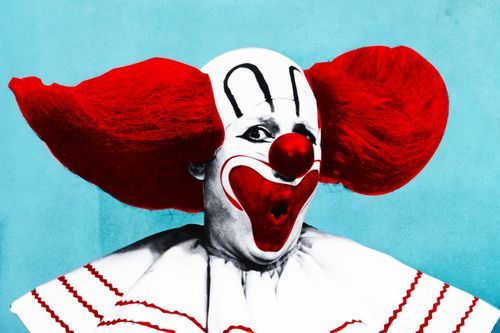
The character was created by Alan W Livingston and portrayed by Pinto Colvig for a children's storytelling record album and illustrative read-along book set in 1946. He became popular during the 1940s and served as the mascot for Capitol Records. The character first appeared on US television in 1949 portrayed by Colvig. After the creative rights to Bozo were purchased by Larry Harmon in 1956, the character became a common franchise across the United States, with local television stations producing their own Bozo shows. Harmon bought out his business partners in 1965 and produced Bozo's Big Top for syndication to local television markets not producing their own Bozo shows in 1966. And then Chicago's Bozo's Circus, which premiered in 1960, went national via cable and satellite in 1978.
Performers who have portrayed Bozo, aside from Colvig and Harmon, include Willard Scott (1959–1962), Frank Avruch (1959–1970), Bob Bell (1960–1984), and Joey D'Auria (1984–2001). Bozo TV shows were also produced in other countries including Mexico, Brazil, Greece, Australia and Thailand. Worst of all, the character inspired the creation of both Ronald McDonald and Krusty the Klown in The Simpsons! And he featured in 157 episodes of his own animated series called Bozo: The World's Most Famous Clown.
It appears that I couldn't have picked a worse name if I'd tried.
I therefore did the grown-up thing. I asked my subscribers to give Bozo a new name. And they came through in spades. I had some cracking submissions like Bufu, Ozbo, Skegcorn and the delightful Naughty Bertram. I had Grimdo (a tribute to Grimaldi), Tuss (a Cornish insult), Bald Ali Buccoli (an anagram of Diabolical Club - my previous book. Clever!), and Bobo ('because it was the name my family gave to a vagina when we were kids').
There were suggestions that played with the clown's Eastern European origins such as Blazen and Pajac which both mean 'clown'. And, unsuprisingly, a lot of suggestions of Bojo. I can't think why ...
But the winner was ... GLUPI!
It sounds like a clown name, doesn't it? Gloopy. Glupi. I love it. And it's Polish for 'stupid', which is singularly appropriate..
Thank you Tom Stevens.
Bye bye Bozo. Hello Glupi!
Until now, that is. It is my sad duty to inform you that Bozo is no more.
It suddenly occurred to me that, with Bozo finally going public, I'd better check that there isn't a real Bozo that I might offend. After all, clowns may not be as popular as they once were, but I'd hate to damage someone's career.
So, first things first, it was off to East London to check out the Clown Egg Register.
Holy Trinity church in Dalston is home to the Clowns’ Gallery Museum, run by Clowns International. That's Joseph Grimaldi there in the stained glass window.


It's a tiny little place full of memorabilia and photographs crammed into three small rooms. But what I was interested in was the register - an archive of ceramic eggs painted to record clowns' personal makeup designs - like a kind of copyright record. The practice started in 1946 when a member of Clowns International (then called the International Circus Clowns Club) called Stan Bult painted the clown faces on emptied-out chicken eggs as a hobby. It evolved into a useful record of faces for posterity, as well as a way to memorialise the great clowns of yore. Bult painted around 200 eggs in total, and while most were lost or broken over the years, 26 of these fragile originals can be found at Dalston along with another 46 ceramic eggs on permanent display. The rest of the clown egg collection is held at Wookey Hole in Somerset.


I first learned about the collection when a fictional version of it appeared in an episode of the classic British 'spy-fi' series The Avengers. There's a series 7 episode called (Stop me if you've heard this one) But there were these two fellers in which a young John Cleese runs the Clown Egg Registry and is visited by Tara King.


I long believed it to be something made up for the show but then, to my delight, I discovered back in the 1990s that it's quite real.


The registry at Dalston caught the attention of photographer Luke Stephenson in 2007 and he published a book of his fantastic photographs of the eggs, taken at Dalston and Wookey Hole.
It's a great little book and, to my delight, it contained no Bozos. And nor did the museum at Dalston. Further researches showed me that there was no registered clown working in the UK under the name. But, and it's a BIG but, when I looked further afield I realised that there was no way I could use the name.
Because, you see, in America Bozo the Clown is as well-known as Basil Brush or the Chuckle Brothers are over here. Sob!

The character was created by Alan W Livingston and portrayed by Pinto Colvig for a children's storytelling record album and illustrative read-along book set in 1946. He became popular during the 1940s and served as the mascot for Capitol Records. The character first appeared on US television in 1949 portrayed by Colvig. After the creative rights to Bozo were purchased by Larry Harmon in 1956, the character became a common franchise across the United States, with local television stations producing their own Bozo shows. Harmon bought out his business partners in 1965 and produced Bozo's Big Top for syndication to local television markets not producing their own Bozo shows in 1966. And then Chicago's Bozo's Circus, which premiered in 1960, went national via cable and satellite in 1978.
Performers who have portrayed Bozo, aside from Colvig and Harmon, include Willard Scott (1959–1962), Frank Avruch (1959–1970), Bob Bell (1960–1984), and Joey D'Auria (1984–2001). Bozo TV shows were also produced in other countries including Mexico, Brazil, Greece, Australia and Thailand. Worst of all, the character inspired the creation of both Ronald McDonald and Krusty the Klown in The Simpsons! And he featured in 157 episodes of his own animated series called Bozo: The World's Most Famous Clown.
It appears that I couldn't have picked a worse name if I'd tried.
I therefore did the grown-up thing. I asked my subscribers to give Bozo a new name. And they came through in spades. I had some cracking submissions like Bufu, Ozbo, Skegcorn and the delightful Naughty Bertram. I had Grimdo (a tribute to Grimaldi), Tuss (a Cornish insult), Bald Ali Buccoli (an anagram of Diabolical Club - my previous book. Clever!), and Bobo ('because it was the name my family gave to a vagina when we were kids').
There were suggestions that played with the clown's Eastern European origins such as Blazen and Pajac which both mean 'clown'. And, unsuprisingly, a lot of suggestions of Bojo. I can't think why ...
But the winner was ... GLUPI!
It sounds like a clown name, doesn't it? Gloopy. Glupi. I love it. And it's Polish for 'stupid', which is singularly appropriate..
Thank you Tom Stevens.
Bye bye Bozo. Hello Glupi!
Published on August 03, 2019 04:09
July 25, 2019
Saving Bletchley Park
Back in 2014, I co-wrote a book called
Saving Bletchley Park
with my dear friend and all-round superwoman Dr Sue Black. She's the lady whose tireless campaign led to the place being saved for the nation. And since then she's become a professor , landed an OBE and been on Desert Island Discs! And deservedly so.
But let's return to June 2014 when we were invited to the grand official opening of Bletchley Park; home of Station X - the code-breaking hothouse that shortened the war by at least two years - and the birthplace of modern computing. To mark the occasion, Kate, Duchess of Cambridge, was in attendance to perform the grand opening and to plant a new tree in the park. The day also marked the end of Phase 1 of the project to save and restore the site.

By this time Sue had finished writing her first-hand blow by blow account of how the campaign began, who the major players were, and how the money was raised. However, the campaign needed to be set against a historical perspective; to tell the story not only of how it was saved but why it had to be saved. So Sue had asked me to research and write this part of the book with her and, as this day marked the completion of the first phase of reconstruction, a description of the day would make a perfect wrap to Sue's story. So I came along, camera in hand, to talk to some of the key players in the campaign and to get some nice 'after' shots to go alongside Sue's 'before' shots of what Bletchley Park looked like when she'd started the campaign in 2009.






I'm not going to write much more as there's very little more I can say. It was wonderful to walk around the grounds, to chat to veterans (sadly, many of which have since passed on) and trustees and to see how wonderfully and sensitively they've restored several of the code-breakers' huts.
I should explain that this isn't some Disney-esque theme park attraction; everything has been done as authentically as possible even down to the half-full ashtrays and grime around the light switches. The huts look as if the staff have simply stepped outside for a break and left the place feeling a little like the Marie Celeste. To see the dingy, narrow corridors, the gas masks and scarves hanging on coat-hooks, the rolled-up maps, and the chalkboards scribbled over with arcane codes is to get a sense of what life was really like during the War. Even in Alan Turing's office, with its iconic tin mug chained to the radiator, it feels like the great man is somehow still in residence.







Lunch on the lawn was a splendid affair and also an opportunity for me to chat to the great and the good including the ex-head of the Royal Navy, Baron West of Spithead (who once appeared on an episode of The Museum of Curiosity) and General Sir Michael Rose, ex-head of the SAS. And, of course, I must mention the Duchess of Cambridge who stoically stood smiling through all of the sandwiches and speeches before performing her royal duties.


What's happened at Bletchley Park is testament to Sue and the others who have run this campaign. It's proof that the ordinary man or woman can make a huge difference ... just as the thousands of ordinary people at Bletchley Park did during WW2, despite knowing that no one would ever learn about the extraordinary work they did for a least four decades.
Saving Bletchley Park by Sue Black and Stevyn Colgan.
All photos (c) Stevyn Colgan and may only be reproduced with permission
But let's return to June 2014 when we were invited to the grand official opening of Bletchley Park; home of Station X - the code-breaking hothouse that shortened the war by at least two years - and the birthplace of modern computing. To mark the occasion, Kate, Duchess of Cambridge, was in attendance to perform the grand opening and to plant a new tree in the park. The day also marked the end of Phase 1 of the project to save and restore the site.

By this time Sue had finished writing her first-hand blow by blow account of how the campaign began, who the major players were, and how the money was raised. However, the campaign needed to be set against a historical perspective; to tell the story not only of how it was saved but why it had to be saved. So Sue had asked me to research and write this part of the book with her and, as this day marked the completion of the first phase of reconstruction, a description of the day would make a perfect wrap to Sue's story. So I came along, camera in hand, to talk to some of the key players in the campaign and to get some nice 'after' shots to go alongside Sue's 'before' shots of what Bletchley Park looked like when she'd started the campaign in 2009.






I'm not going to write much more as there's very little more I can say. It was wonderful to walk around the grounds, to chat to veterans (sadly, many of which have since passed on) and trustees and to see how wonderfully and sensitively they've restored several of the code-breakers' huts.
I should explain that this isn't some Disney-esque theme park attraction; everything has been done as authentically as possible even down to the half-full ashtrays and grime around the light switches. The huts look as if the staff have simply stepped outside for a break and left the place feeling a little like the Marie Celeste. To see the dingy, narrow corridors, the gas masks and scarves hanging on coat-hooks, the rolled-up maps, and the chalkboards scribbled over with arcane codes is to get a sense of what life was really like during the War. Even in Alan Turing's office, with its iconic tin mug chained to the radiator, it feels like the great man is somehow still in residence.







Lunch on the lawn was a splendid affair and also an opportunity for me to chat to the great and the good including the ex-head of the Royal Navy, Baron West of Spithead (who once appeared on an episode of The Museum of Curiosity) and General Sir Michael Rose, ex-head of the SAS. And, of course, I must mention the Duchess of Cambridge who stoically stood smiling through all of the sandwiches and speeches before performing her royal duties.


What's happened at Bletchley Park is testament to Sue and the others who have run this campaign. It's proof that the ordinary man or woman can make a huge difference ... just as the thousands of ordinary people at Bletchley Park did during WW2, despite knowing that no one would ever learn about the extraordinary work they did for a least four decades.
Saving Bletchley Park by Sue Black and Stevyn Colgan.
All photos (c) Stevyn Colgan and may only be reproduced with permission
Published on July 25, 2019 03:49
July 11, 2019
What else can I say?
Published on July 11, 2019 04:35
July 4, 2019
Here we go again ...
I've just announced that my third novel will be called
Cockerings
.
Yes, Cockerings (it's pronounced as 'Corrings).
It's a book that's been a looooooong time coming ...
Back in the late 1980s/early 1990s - before some of you were even born I suspect - I shared an office at Hendon Police College in London with a chap called Chris Hale. We were members of the Met Police's training and curriculum design team and part of our workload consisted of writing scenarios for prospective promotion candidates to use as mock exams before they faced the real thing. These scenarios were called Knowledge and Reasoning Tests, or K&Rs. What we had to to do was set up a situation on paper and then ask the candidates to prove their mettle by identifying which, if any, offences were being committed and by describing what course(s) of action they would take. We did this once a month for several years. But then, responsibility for writing these K&Rs was taken over by the Home Office. This was good because it freed us up to do other work, but we also knew that we'd miss writing them as the K&Rs were the most creative and fun part of our jobs. So Chris and I decided that we'd go out with a bang. For our final promotion class mock exam K&R, we would create the maddest, most ridiculous (though still possible) scenario ever. It involved a geriatric circus, a catastrophic fire, drunk clowns, a troupe of aged trapeze artists, escaped tigers, an incontinent elephant and so much more. The promotion candidates loved it. And, afterwards, I realised that the idea of a geriatric circus was just too good to throw away. So, with Chris's blessing, I wrote a short comic story about the circus and about Bozo the Silesian clown called The Big Flop.
Then, in 1992, I expanded the story into a full-length novel called Pumps and Circustents in which the circus came up against a secret society. Here's a photo of the only existing copy of that novel (and written before I'd adopted the Cornish 'Stevyn' as a way to sift me from all the other Stephen Colgans worldwide).

The reason that it's the only copy is that in 1993, I suffered a catastrophic hard disk crash and lost the whole thing - all 92,000 words of it! I was heartbroken. Thankfully, I'd printed it out. But it was a harsh lesson in learning to back up your work and I've never lost a file again.
The millennium came and went and I had an idea for a completely different novel that could involve Bozo and his circus of pensioners. Very soon it had evolved into a novel called Going Out With A Bang in which the circus got caught up in an armed robbery. I submitted it to my agent and he liked it. He then floated past the commissioning editors of several major publishers. And they all said much the same thing: 'We really like this'; 'This is well-written and very funny'; 'I loved every minute of it'. But then they also said, 'Unfortunately no one is publishing comedy novels right now so we can't see where to place it in the market. Can he write a Dan Brown type book instead?' I'll admit that I felt very disheartened and I returned to writing non-fiction for a while.
Then, in 2016, and having had several non-fic books published, I thought I'd try again. I had a new agent and he liked the book. However, he got the same response from trad publishers that his predecessor had, except now they said 'Can he write a Scandi-Noir type book instead?' So I pitched it to the innovative new hybrid publisher Unbound and they liked it too. Unbound is a traditional publisher in every sense. However, they use crowdfunding to let readers decide whether books get published and not some nameless accountant.
At last Cockerings, as it was now called, would be published!
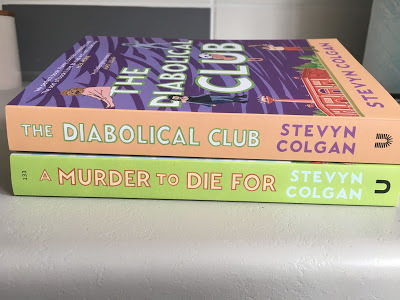
But then Unbound asked me if it was a one-off novel or part of a series and I told them about the other novels I'd written. After some discussion they decided that it would be prudent to put A Murder To Die For out first as it would hit two audiences at once: comedy and murder mystery. That would give me a greater chance of success, they said. And they were right - the book did well and was nominated for two awards. And then, because there were plot strands to tie up and stories to resolve, I had to publish the sequel, The Diabolical Club , which, curiously enough, ended up using left-over material - the stuff about the secret society - that had originally been in Pumps and Circustents way back in the Nineties.
In writing, all ideas are recyclable!
But now, finally, it's the turn of Cockerings to take its place in the spotlight. It's been nearly 30 years since Bozo and his aged entertainers first came creaking and grumbling into my life and they feel like old and much-loved friends. Our journey together has been bumpy, occasionally heartbreaking, but always entertaining. All of which is why I am SO delighted to announce that the book will now be a reality.
This book means more to me than any other I've written because it's been with me for so long. Those who have read it tell me that it's the funniest thing I've written to date. I hope that's true.
And I can't wait to share it with you.
See link (right) or click here for more details.
Yes, Cockerings (it's pronounced as 'Corrings).
It's a book that's been a looooooong time coming ...
Back in the late 1980s/early 1990s - before some of you were even born I suspect - I shared an office at Hendon Police College in London with a chap called Chris Hale. We were members of the Met Police's training and curriculum design team and part of our workload consisted of writing scenarios for prospective promotion candidates to use as mock exams before they faced the real thing. These scenarios were called Knowledge and Reasoning Tests, or K&Rs. What we had to to do was set up a situation on paper and then ask the candidates to prove their mettle by identifying which, if any, offences were being committed and by describing what course(s) of action they would take. We did this once a month for several years. But then, responsibility for writing these K&Rs was taken over by the Home Office. This was good because it freed us up to do other work, but we also knew that we'd miss writing them as the K&Rs were the most creative and fun part of our jobs. So Chris and I decided that we'd go out with a bang. For our final promotion class mock exam K&R, we would create the maddest, most ridiculous (though still possible) scenario ever. It involved a geriatric circus, a catastrophic fire, drunk clowns, a troupe of aged trapeze artists, escaped tigers, an incontinent elephant and so much more. The promotion candidates loved it. And, afterwards, I realised that the idea of a geriatric circus was just too good to throw away. So, with Chris's blessing, I wrote a short comic story about the circus and about Bozo the Silesian clown called The Big Flop.
Then, in 1992, I expanded the story into a full-length novel called Pumps and Circustents in which the circus came up against a secret society. Here's a photo of the only existing copy of that novel (and written before I'd adopted the Cornish 'Stevyn' as a way to sift me from all the other Stephen Colgans worldwide).

The reason that it's the only copy is that in 1993, I suffered a catastrophic hard disk crash and lost the whole thing - all 92,000 words of it! I was heartbroken. Thankfully, I'd printed it out. But it was a harsh lesson in learning to back up your work and I've never lost a file again.
The millennium came and went and I had an idea for a completely different novel that could involve Bozo and his circus of pensioners. Very soon it had evolved into a novel called Going Out With A Bang in which the circus got caught up in an armed robbery. I submitted it to my agent and he liked it. He then floated past the commissioning editors of several major publishers. And they all said much the same thing: 'We really like this'; 'This is well-written and very funny'; 'I loved every minute of it'. But then they also said, 'Unfortunately no one is publishing comedy novels right now so we can't see where to place it in the market. Can he write a Dan Brown type book instead?' I'll admit that I felt very disheartened and I returned to writing non-fiction for a while.
Then, in 2016, and having had several non-fic books published, I thought I'd try again. I had a new agent and he liked the book. However, he got the same response from trad publishers that his predecessor had, except now they said 'Can he write a Scandi-Noir type book instead?' So I pitched it to the innovative new hybrid publisher Unbound and they liked it too. Unbound is a traditional publisher in every sense. However, they use crowdfunding to let readers decide whether books get published and not some nameless accountant.
At last Cockerings, as it was now called, would be published!

But then Unbound asked me if it was a one-off novel or part of a series and I told them about the other novels I'd written. After some discussion they decided that it would be prudent to put A Murder To Die For out first as it would hit two audiences at once: comedy and murder mystery. That would give me a greater chance of success, they said. And they were right - the book did well and was nominated for two awards. And then, because there were plot strands to tie up and stories to resolve, I had to publish the sequel, The Diabolical Club , which, curiously enough, ended up using left-over material - the stuff about the secret society - that had originally been in Pumps and Circustents way back in the Nineties.
In writing, all ideas are recyclable!
But now, finally, it's the turn of Cockerings to take its place in the spotlight. It's been nearly 30 years since Bozo and his aged entertainers first came creaking and grumbling into my life and they feel like old and much-loved friends. Our journey together has been bumpy, occasionally heartbreaking, but always entertaining. All of which is why I am SO delighted to announce that the book will now be a reality.
This book means more to me than any other I've written because it's been with me for so long. Those who have read it tell me that it's the funniest thing I've written to date. I hope that's true.
And I can't wait to share it with you.
See link (right) or click here for more details.
Published on July 04, 2019 23:07
July 3, 2019
Puppetry of the Pizza
All of the best stories have their roots in real life.
Following on from my last post about the origins of Cockerings , let me explain where some of my inspiration for the circus characters came from.
Back in the early 1980s, when I was a young cop pounding the beat in Uxbridge, West London, there was a pizza joint near the bus station called Stanelli’s. I often thought, as I wandered past, that it would be quite funny to discover that the owner was actually called Stan Ellis (he wasn’t) and that he’d adopted the Italian sounding name in order to sell more pizzas (he hadn’t).
So, when I began thinking of a name for the circus in Cockerings, the name Stanelli’s tumbled out of my memory. It was perfect and it would allow me to use the Stan Ellis gag. However, I first decided to google it - just in case the pizza place was still going or, indeed, if there really was a circus called Stanelli's). And to my utter surprise there was! Except ... it was a puppet circus.

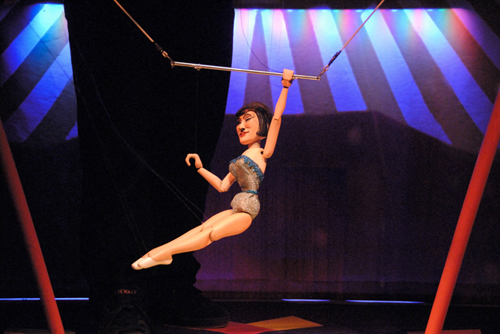
The very talented British puppet maker and performer Stan Parker had once created and toured a show called Stanelli’s Super Circus. Some of his splendid puppets are peppered throughout this post (all photos from www.stanparkerpuppets.co.uk). The moment I saw them I was smitten. These puppets were so close to how I imagined the characters in my geriatric circus would look. It was like suddenly seeing my players made flesh (or wood, anyway). The Flying Mannings’ trapeze troupe. Della the incontinent elephant. Strongitharm the balding strong man. And a character that I mentioned in my previous blogpost and who I'm sure you'll grow to love - Bozo the alcoholic clown.
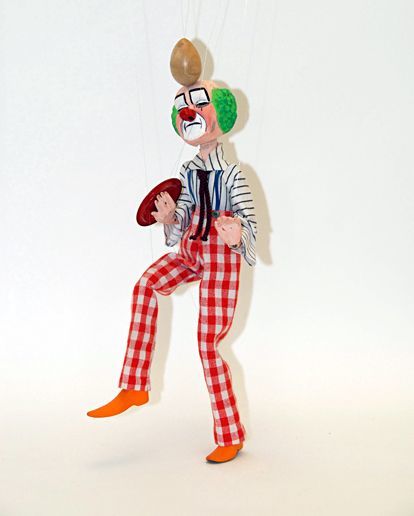

Parker died in 2004 at the age of 78. But in his time he performed all over Europe, Japan, Korea, Israel, Pakistan and even the USSR. His beautiful hand-made puppets became a huge inspiration for me and were always in my mind as I was writing the book. There are some lovely videos of the puppets in use here. But here's one of them.
I’m pleased to report that when he died, his collection of puppets was saved for the nation thanks to a grant from the National Lottery. It’s now safely housed and archived at the Up Front Puppet Theatre in Cumbria.



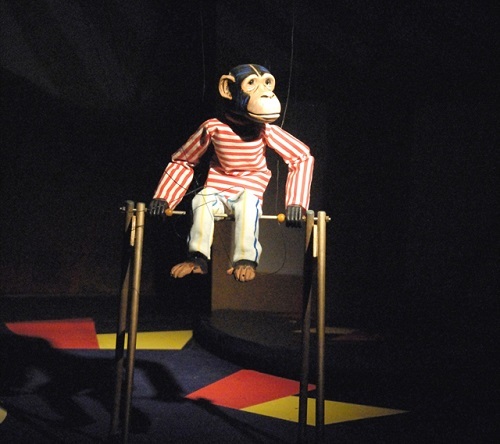
Naturally, I wanted to include a tribute to Parker’s work in the book but, obviously, I didn’t want to cause any copyright hassles by using the name Stanelli’s.
So that was how Ben Ellis and Benelli’s Circus was born.
Different name, same gag.
Isn’t it amazing where a pizza can lead you?
Following on from my last post about the origins of Cockerings , let me explain where some of my inspiration for the circus characters came from.
Back in the early 1980s, when I was a young cop pounding the beat in Uxbridge, West London, there was a pizza joint near the bus station called Stanelli’s. I often thought, as I wandered past, that it would be quite funny to discover that the owner was actually called Stan Ellis (he wasn’t) and that he’d adopted the Italian sounding name in order to sell more pizzas (he hadn’t).
So, when I began thinking of a name for the circus in Cockerings, the name Stanelli’s tumbled out of my memory. It was perfect and it would allow me to use the Stan Ellis gag. However, I first decided to google it - just in case the pizza place was still going or, indeed, if there really was a circus called Stanelli's). And to my utter surprise there was! Except ... it was a puppet circus.


The very talented British puppet maker and performer Stan Parker had once created and toured a show called Stanelli’s Super Circus. Some of his splendid puppets are peppered throughout this post (all photos from www.stanparkerpuppets.co.uk). The moment I saw them I was smitten. These puppets were so close to how I imagined the characters in my geriatric circus would look. It was like suddenly seeing my players made flesh (or wood, anyway). The Flying Mannings’ trapeze troupe. Della the incontinent elephant. Strongitharm the balding strong man. And a character that I mentioned in my previous blogpost and who I'm sure you'll grow to love - Bozo the alcoholic clown.


Parker died in 2004 at the age of 78. But in his time he performed all over Europe, Japan, Korea, Israel, Pakistan and even the USSR. His beautiful hand-made puppets became a huge inspiration for me and were always in my mind as I was writing the book. There are some lovely videos of the puppets in use here. But here's one of them.
I’m pleased to report that when he died, his collection of puppets was saved for the nation thanks to a grant from the National Lottery. It’s now safely housed and archived at the Up Front Puppet Theatre in Cumbria.




Naturally, I wanted to include a tribute to Parker’s work in the book but, obviously, I didn’t want to cause any copyright hassles by using the name Stanelli’s.
So that was how Ben Ellis and Benelli’s Circus was born.
Different name, same gag.
Isn’t it amazing where a pizza can lead you?
Published on July 03, 2019 04:54
June 20, 2019
It's finally here!
Yes indeed.
The Diabolical Club
now physically exists. It's n sale from July 11th through Amazon, bookshops and wherever books are sold.
Published on June 20, 2019 05:37
June 13, 2019
Dwile Flonking for Gold
The first physical copies of
The Diabolical Club
arrived this week, which is fantastic. The three things that always get me revved up are (1) seeing the physical book for the first time, (2) seeing it in a bookshop, and (3) seeing someone reading it. All very exciting!
The books are printed by a long-established company called Clays from Bungay in Suffolk and, as I saw the name on the outside of the delivery box, something began tickling at the back of my memory. Isn't Bungay one of the places where they still play Dwile Flonking?

Dwile Flonking is an East Anglian 'sport' which some people would have you believe is centuries old. In fact, it's most likely only around 50 years old, but it may be a revival of some old harvest ritual. The modern game is believed to have been created in the 1960s by rival printing apprentices at Clowes of Beccles and Clays of Bungay.
At Midday the two teams assemble - usually in a pub garden - and dressed as yokels. The referee, or Jobanowl, decides which team goes first by throwing up a sugar beet. The teams then become either Flonkers or Girters. Girters form a circle by holding hands and they surround the first Flonker in to 'bat'. The Flonker holds a short pole called a Driveller and uses it to pick up the Dwile - a beer-soaked bar towel - from a chamber pot full of beer that stands in the centre of the circle. Upon the command of 'Here y'go t'gither!' the Girters start to dance around clockwise while the Flonker goes anti-clockwise around the chamber pot and attempts to 'Flonk' the Dwile at one of the Girters.
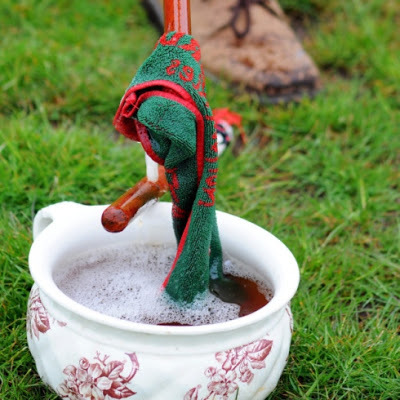
A direct hit on a Girter's head is called a Wanton and scores three points. A hit on the body is called a Marther and is worth two points. A leg hit is a Ripper and scores just one point. If the Flonker misses all of the Girters it's called a Swodger. The Girters then form a straight line and the outgoing player must down a pint of ale in a quicker time than it takes for the Dwile to be handed down the line of Girters. If they can't do it, they're out and the next Flonker comes in. This continues until the whole team is out. Then the teams swap over. Once everyone has Flonked the winning team is decided on points.
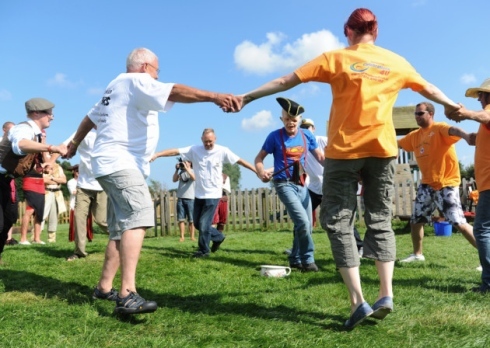
Unsurprisingly, many of the players end up riotously drunk, falls are common and there are occasional casualties as the result of a good hard Wanton. Which is why the sport has been banned on several occasions for violating health and safety regulations. But it continues to persist and, if anything, trying to ban it just makes the British want to play it even more.
That says so much about the British character doesn't it? It's why attempts to ban cheese rolling at Cooper's Hill in Gloucestershire have failed (they tried to ban it but people held the race in secret at night with the potential for greater injuries). It's why we play River Football in Bourton-On-The Water, and go Bog Snorkelling in Llanwrtyd Wells. It's why the Haxey Hood takes place in Lincolnshire, and Shin Kicking in Lancashire, and Cornish Hurling in St Ives and St Columb Major - a sport that has only one rule: No Weapons. But we should embrace these silly sports because, in a strange way, they led to the modern Olympics.
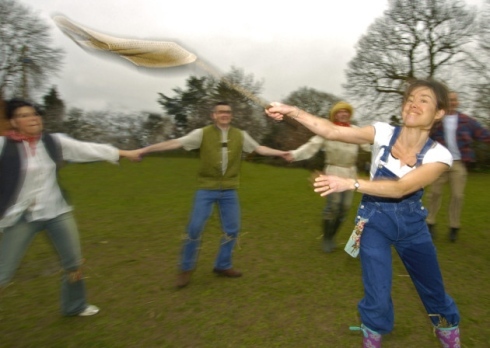
The Cotswold Olympicks were first held in 1612 on Dover's Hill, Chipping Camden, and survived until 1652 when the Puritans shut it down. It featured Shin-Kicking, Tug Of War, Sack Races, Sheaf Throwing (lobbing a hay bale as far as you can with a pitchfork), climbing a greasy pole, Morris Dancing and Back Swording (or 'Cudgel Play) in which contestants keep hitting each other until one is unconscious. The Olympicks returned after the Restoration and continued for another 200 years before being, once again, shut down by the authorities. But, by then, the event had inspired Dr William Penny Brookes to create the Wenlock Games at Much Wenlock, Shropshire in 1850. And it is these games that directly inspired the creation of the modern Olympics in 1896. Which is why, for the 2012 London Olympics, the mascots were called Wenlock and Mandeville (the latter named after Stoke Mandeville Hospital in Buckinghamshire where the Paralympics were created).
So there you go. The British may like a daft sport or two but who knows where a silly idea might take you? It might take you all the way to a gold medal.
Photos taken from the Beccles and Bungay Journal
The books are printed by a long-established company called Clays from Bungay in Suffolk and, as I saw the name on the outside of the delivery box, something began tickling at the back of my memory. Isn't Bungay one of the places where they still play Dwile Flonking?

Dwile Flonking is an East Anglian 'sport' which some people would have you believe is centuries old. In fact, it's most likely only around 50 years old, but it may be a revival of some old harvest ritual. The modern game is believed to have been created in the 1960s by rival printing apprentices at Clowes of Beccles and Clays of Bungay.
At Midday the two teams assemble - usually in a pub garden - and dressed as yokels. The referee, or Jobanowl, decides which team goes first by throwing up a sugar beet. The teams then become either Flonkers or Girters. Girters form a circle by holding hands and they surround the first Flonker in to 'bat'. The Flonker holds a short pole called a Driveller and uses it to pick up the Dwile - a beer-soaked bar towel - from a chamber pot full of beer that stands in the centre of the circle. Upon the command of 'Here y'go t'gither!' the Girters start to dance around clockwise while the Flonker goes anti-clockwise around the chamber pot and attempts to 'Flonk' the Dwile at one of the Girters.

A direct hit on a Girter's head is called a Wanton and scores three points. A hit on the body is called a Marther and is worth two points. A leg hit is a Ripper and scores just one point. If the Flonker misses all of the Girters it's called a Swodger. The Girters then form a straight line and the outgoing player must down a pint of ale in a quicker time than it takes for the Dwile to be handed down the line of Girters. If they can't do it, they're out and the next Flonker comes in. This continues until the whole team is out. Then the teams swap over. Once everyone has Flonked the winning team is decided on points.

Unsurprisingly, many of the players end up riotously drunk, falls are common and there are occasional casualties as the result of a good hard Wanton. Which is why the sport has been banned on several occasions for violating health and safety regulations. But it continues to persist and, if anything, trying to ban it just makes the British want to play it even more.
That says so much about the British character doesn't it? It's why attempts to ban cheese rolling at Cooper's Hill in Gloucestershire have failed (they tried to ban it but people held the race in secret at night with the potential for greater injuries). It's why we play River Football in Bourton-On-The Water, and go Bog Snorkelling in Llanwrtyd Wells. It's why the Haxey Hood takes place in Lincolnshire, and Shin Kicking in Lancashire, and Cornish Hurling in St Ives and St Columb Major - a sport that has only one rule: No Weapons. But we should embrace these silly sports because, in a strange way, they led to the modern Olympics.

The Cotswold Olympicks were first held in 1612 on Dover's Hill, Chipping Camden, and survived until 1652 when the Puritans shut it down. It featured Shin-Kicking, Tug Of War, Sack Races, Sheaf Throwing (lobbing a hay bale as far as you can with a pitchfork), climbing a greasy pole, Morris Dancing and Back Swording (or 'Cudgel Play) in which contestants keep hitting each other until one is unconscious. The Olympicks returned after the Restoration and continued for another 200 years before being, once again, shut down by the authorities. But, by then, the event had inspired Dr William Penny Brookes to create the Wenlock Games at Much Wenlock, Shropshire in 1850. And it is these games that directly inspired the creation of the modern Olympics in 1896. Which is why, for the 2012 London Olympics, the mascots were called Wenlock and Mandeville (the latter named after Stoke Mandeville Hospital in Buckinghamshire where the Paralympics were created).
So there you go. The British may like a daft sport or two but who knows where a silly idea might take you? It might take you all the way to a gold medal.
Photos taken from the Beccles and Bungay Journal
Published on June 13, 2019 01:34
April 20, 2019
No Parking!
Published on April 20, 2019 04:28
April 6, 2019
Cover me up!
It's time for a cover reveal.
No, it's time for a double cover reveal.
Here's the brilliant Neil Gower's cover for The Diabolical Club .
(Ignore the quotes - they're just placeholders I borrowed from A Murder To Die For . Real quotes to follow.)

As the book is set in October, we went for Autumnal colours. They contrast beautifully with the Springtime theme of the previous book.
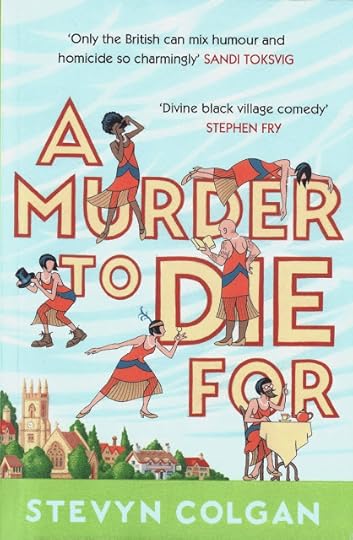
I'm delighted with both covers. And I'm also very pleased with this cover, which resonates nicely with the novels:

As you may (or may not) know, everyone who subscribes to The Diabolical Club will get a free bonus e-book of short stories called The Nearly Invisible Man. This won't be available to buy in the shops so, if you want to read stories about the extraordinary detective Gavin Quisty, or the eccentric Mr Spurgeon and his flag collection, you need to pledge NOW.
Click here!
And do it soon as the funding campaign will be shutting shortly. What you'll get is an early copy of the book (published 11th July), plus the e-book (which also features a two chapter teaser of my next novel, Cockerings ) and you'll get your name printed in the book as a patron.
So click here and pledge now!
No, it's time for a double cover reveal.
Here's the brilliant Neil Gower's cover for The Diabolical Club .
(Ignore the quotes - they're just placeholders I borrowed from A Murder To Die For . Real quotes to follow.)

As the book is set in October, we went for Autumnal colours. They contrast beautifully with the Springtime theme of the previous book.

I'm delighted with both covers. And I'm also very pleased with this cover, which resonates nicely with the novels:

As you may (or may not) know, everyone who subscribes to The Diabolical Club will get a free bonus e-book of short stories called The Nearly Invisible Man. This won't be available to buy in the shops so, if you want to read stories about the extraordinary detective Gavin Quisty, or the eccentric Mr Spurgeon and his flag collection, you need to pledge NOW.
Click here!
And do it soon as the funding campaign will be shutting shortly. What you'll get is an early copy of the book (published 11th July), plus the e-book (which also features a two chapter teaser of my next novel, Cockerings ) and you'll get your name printed in the book as a patron.
So click here and pledge now!
Published on April 06, 2019 23:56



